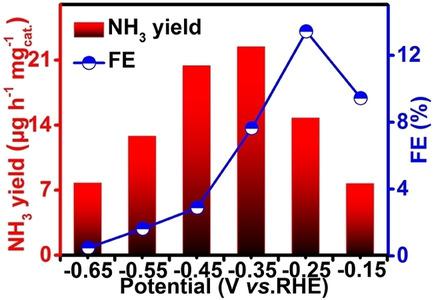当前位置:
X-MOL 学术
›
ChemNanoMat
›
论文详情
Our official English website, www.x-mol.net, welcomes your feedback! (Note: you will need to create a separate account there.)
Greatly Enhanced Electrocatalytic N2 Reduction over V2O3/C by P Doping
ChemNanoMat ( IF 3.8 ) Pub Date : 2020-07-17 , DOI: 10.1002/cnma.202000110 Xin Cheng 1 , Jianwei Wang 2 , Wei Xiong 1 , Ting Wang 3 , Tongwei Wu 3 , Siyu Lu 4 , Guang Chen 5 , Shuyan Gao 6 , Xifeng Shi 7 , Zhenju Jiang 1 , Xiaobin Niu 2 , Xuping Sun 3
ChemNanoMat ( IF 3.8 ) Pub Date : 2020-07-17 , DOI: 10.1002/cnma.202000110 Xin Cheng 1 , Jianwei Wang 2 , Wei Xiong 1 , Ting Wang 3 , Tongwei Wu 3 , Siyu Lu 4 , Guang Chen 5 , Shuyan Gao 6 , Xifeng Shi 7 , Zhenju Jiang 1 , Xiaobin Niu 2 , Xuping Sun 3
Affiliation

|
As a carbon‐neutral alternative technology to the Haber−Bosch process, electrochemical N2 reduction enables eco‐friendly NH3 synthesis under ambient conditions but requires electrocatalysts to drive the N2 reduction reaction (NRR). Here, P doping is proposed as a valid strategy to greatly increase the NRR activity of the V2O3/C shuttle‐like nanostructure. In 0.1 M Na2SO4, the NH3 yield of original V2O3/C is 12.6 μg h−1 mg−1cat. and a Faraday efficiency (FE) of 6.06% at −0.45 V and −0.25 V vs. reversible hydrogen electrode (RHE), respectively. P‐doped V2O3/C (P−V2O3/C), with a mass ratio of P of 6.05%, is capable of achieving a large NH3 yield of 22.4 μg h−1 mg−1cat. at −0.35 V vs. RHE, and a high FE of 13.78% at −0.25 V vs. RHE. It also shows high electrochemical durability and outstanding selectivity for NH3 formation. Combined with density functional theory calculations, the catalytic mechanism was further explored.
中文翻译:

通过P掺杂大大增强了V2O3 / C上的电催化N2还原
作为Haber-Bosch工艺的碳中和替代技术,电化学还原N 2可以在环境条件下合成环保的NH 3,但需要电催化剂来驱动N 2还原反应(NRR)。在这里,P掺杂被认为是有效增加V 2 O 3 / C穿梭状纳米结构的NRR活性的有效策略。在0.1 M Na 2 SO 4中,原始V 2 O 3 / C的NH 3产率为12.6μgh -1 mg -1 cat。与可逆氢电极(RHE)相比,在-0.45 V和-0.25 V时法拉第效率(FE)分别为6.06%。P质量比为6.05%的P掺杂V 2 O 3 / C(P-V 2 O 3 / C)能够实现22.4μgh -1 mg -1 cat的大NH 3收率。相对于RHE为-0.35 V时,以及-0.25 V对RHE时的高FE为13.78%。它还显示出高电化学耐久性和对NH 3形成的出色选择性。结合密度泛函理论计算,进一步探讨了催化机理。
更新日期:2020-07-17
中文翻译:

通过P掺杂大大增强了V2O3 / C上的电催化N2还原
作为Haber-Bosch工艺的碳中和替代技术,电化学还原N 2可以在环境条件下合成环保的NH 3,但需要电催化剂来驱动N 2还原反应(NRR)。在这里,P掺杂被认为是有效增加V 2 O 3 / C穿梭状纳米结构的NRR活性的有效策略。在0.1 M Na 2 SO 4中,原始V 2 O 3 / C的NH 3产率为12.6μgh -1 mg -1 cat。与可逆氢电极(RHE)相比,在-0.45 V和-0.25 V时法拉第效率(FE)分别为6.06%。P质量比为6.05%的P掺杂V 2 O 3 / C(P-V 2 O 3 / C)能够实现22.4μgh -1 mg -1 cat的大NH 3收率。相对于RHE为-0.35 V时,以及-0.25 V对RHE时的高FE为13.78%。它还显示出高电化学耐久性和对NH 3形成的出色选择性。结合密度泛函理论计算,进一步探讨了催化机理。


























 京公网安备 11010802027423号
京公网安备 11010802027423号